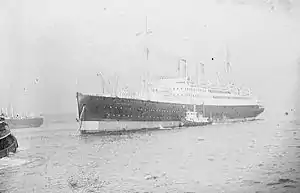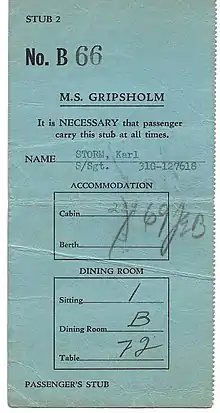MS Gripsholm (1924)
MS Gripsholm was an ocean liner, built in 1924 by Armstrong Whitworth in Newcastle-upon-Tyne, England, for the Swedish American Line for use in the Gothenburg-New York City run. She was of great historical importance as the first ship built for transatlantic express service as a diesel-powered motor vessel, rather than as a steamship.
 Gripsholm in her original black-hulled livery | |
| History | |
|---|---|
| Name: | Gripsholm |
| Owner: | Swedish American Line |
| Builder: | Armstrong Whitworth & Co. Ltd.[1] |
| Yard number: | 999 |
| Launched: | 26 Nov 1924 |
| Completed: | Nov 1925 |
| Maiden voyage: | 1925 |
| In service: | 1925–1954 |
| Fate: | Sold to Germany, 1954 |
| History | |
| Name: | Berlin |
| Owner: | North German Lloyd |
| In service: | 1954–1966 |
| Fate: | Scrapped in 1966 |
| General characteristics | |
| Type: | Passenger liner |
| Tonnage: | 17,993 GRT |
| Length: | 573 ft (174.7 m) |
| Beam: | 74 ft (22.6 m) |
| Installed power: | Burmeister & Wain diesels |
| Propulsion: | Two shafts |
| Speed: | 16 knots (30 km/h; 18 mph) |
| Capacity: | 127 first class482 second class948 third class |
| Crew: | 360 |
| Notes: | [2] |
Initial service
From 1927 onwards, the Gripsholm made transatlantic passenger crossings and regular recreational cruises. Gripsholm was one of the first ships to call at the Canadian Pier 21 immigration terminal in Halifax, Nova Scotia and made 101 trips with immigrants to Pier 21.[3]
Exchange and repatriation ship

From 1942 to 1946, the United States Department of State chartered Gripsholm as an exchange and repatriation ship, carrying Japanese[4] and German nationals to exchange points where she then picked up US and Canadian citizens (and British married to Americans or Canadians) to bring home to the USA and Canada. In this service she sailed under the auspices of the International Red Cross, with a Swedish captain and crew. The ship made 12 round trips, carrying a total of 27,712 repatriates. Exchanges took place at neutral ports; at Lourenço Marques (now Maputo) in Mozambique or Mormugoa (now Goa) in Portuguese India with the Japanese, and Stockholm or Lisbon with the Germans.
After the war, Gripsholm was used to deport inmates of US prisons to Italy and Greece.


Post-war service and renaming

The Swedish American Line sold Gripsholm to Norddeutscher Lloyd in 1954, who renamed her MS Berlin. As MS Berlin, the ship resumed Canadian immigration voyages to Pier 21 in Halifax, making 33 immigrant voyages before the ship was retired.[5] An image of MS Berlin arriving at Pier 21 in 1957[6] became the centre image of the newly redesigned Canadian epassport in 2012.[7]
The ship was sold for scrap in 1966.
Passengers of note
Regular service
- Ernest Hemingway, American novelist, short story writer, and journalist, sailed with wife Pauline Pfeiffer from Mombasa to Villefranch in early 1934, and again with her in January 1938 from Southampton to Nassau after his return from Spain reporting on the Spanish Civil War.
- Anton Koschany, Canadian news producer, W5, immigrated to Canada as a child on the sailing of March 22, 1956 from Bremerhaven, in company of his mother and sister.
Exchange and repatriation ship
- Joseph Alsop, not as a Naval Press Officer stranded in Hong Kong, but as a news reporter.
- Gilberto Bosques, Mexican Consul General in Marseille, credited with issuing 40,000 visas to fleeing Spanish Republicans, Jews and other persecuted individuals in 1939-1943, on board (with his wife and 3 children) the MS Gripsholm sailing from Lisbon March 6, 1944, after having been imprisoned at the Rheinhotel Dreesen in Bad Godesberg for one year.
- Cornell Franklin, former Chairman of the Shanghai Municipal Council, was repatriated from Shanghai in 1943, taking the Gripsholm from Goa.
- Joseph Grew, US Ambassador to Japan, was repatriated from Tokyo in 1942, taking the Gripsholm from Lourenço Marques.
- Milton Helmick, judge of the United States Court for China, was repatriated from Shanghai in 1942, taking the Gripsholm from Lourenço Marques.
- Saburō Kurusu, Japanese peace envoy who was in the US when Pearl Harbor was attacked, was repatriated to Japan via Lourenço Marques in 1942.
- Pedro Inzunza McKay, Mexican diplomat, native of Mocorito, Sinaloa, subsequently Mexico's ambassador in Cuba and Brazil, on board the MS Gripsholm, with his French wife Marie Louise, sailing from Lisbon March 6, 1944, after having been imprisoned at the Rheinhotel Dreesen in Bad Godesberg for one year.
- Gregon A. Williams, Marine Corps Officer; Assistant Naval Attaché in Shanghai, was repatriated from Shanghai in 1942.
- May De Sousa, American actress famous for operetta; was repatriated from Chapei Civilian Assembly Center in Shanghai in 1943.
References
- "MS Gripsholm (1925)". www.tynebuiltships.co.uk. Retrieved 15 Jun 2017.
- The First Great Ocean Liners (pg 116) William H. Miller 1984 General Publishing Co. Ltd Canada
- "Gripsholm", Ship Arrivals Database, Canadian Museum of Immigration at Pier 21
- Elleman, Bruce (2006). Japanese-American civilian prisoner exchanges and detention camps, 1941-45. Routledge. p. 31. ISBN 978-0-415-33188-3. Retrieved 14 September 2009.
- "Berlin", Ship Arrivals Database, Canadian Museum of Immigration at Pier 21
- Wetmore Collection, Library and Archives Canada, PA-187858
- "The Canadian Museum of Immigration at Pier 21 will be part of Canada’s new ePassport", Canadian Museum of Immigration at Pier 21, October 26, 2012
External links
- The Great Ocean Liners: Gripsholm (I)
- A Tribute to the Swedish American Line: Gripsholm 1925-1954
- (in Swedish) Fakta om Fartyg: MS Gripsholm (1925)
History